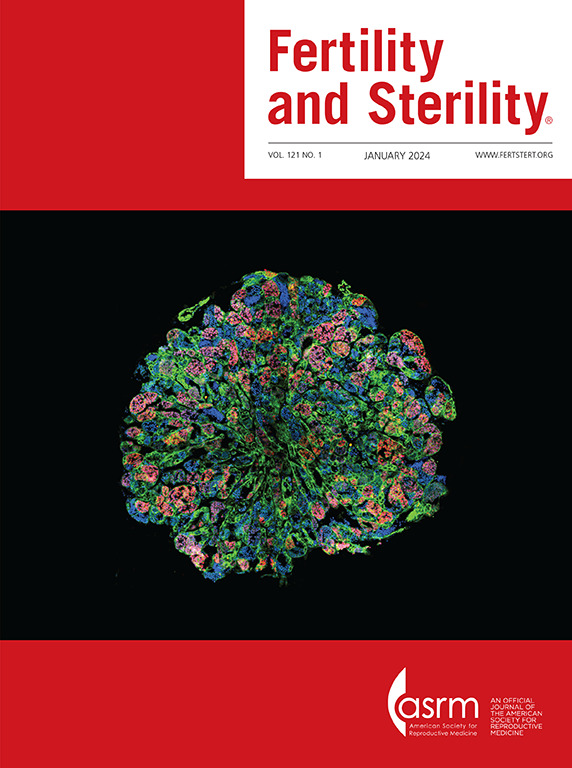Epigenetic implications of socioeconomic status and education on sperm DNA methylation patterns
IF 7
1区 医学
Q1 OBSTETRICS & GYNECOLOGY
引用次数: 0
Abstract
Objective
To identify differentially methylated regions and assess epigenetic age and instability scores within each cohort of differing income levels and educational attainment.
Design
Retrospective analysis of epigenetic data.
Subjects
A total of 1,429 semen samples from participants in the Folic Acid and Zinc Supplementation Trial study.
Exposure
Socioeconomic status, approximated by self-reported income, and education level.
Main Outcome Measures
Differential sperm DNA methylation, epigenetic age, epigenetic stability.
Results
There were four significant differentially methylated regions associated with the income cohorts and seven associated with the education cohorts, suggesting epigenetic patterns vary with socioeconomic status. Adjusted epigenetic age (germ-line age differential values) did not differ significantly in either cohort; however, a higher number of unstable promoters were observed in the lowest education cohort, indicating dysregulation in the epigenome.
Conclusion
These findings suggest a biologic link between income and education level in sperm epigenetic patterns, which may influence reproductive health. The increase in unstable promoters in the lower education cohorts may contribute to health disparities associated with educational attainment; however, it is important to consider lifestyle factors and environmental exposures as potential underlying causes. Further research is needed to fully elucidate the implications of these epigenetic changes and their relationship to health outcomes.
Clinical Trial Registration Number
Clinicaltrials.gov, NCT#01857310.
Implicaciones epigenéticas del estatus socioeconómico y la educación en los patrones de metilación del ADN espermático
Objetivo
Identificar regiones diferencialmente metiladas y evaluar la edad epigenética y los índices de inestabilidad dentro de cada cohorte según los diferentes niveles de ingresos y el grado de escolaridad.
Diseño
Análisis retrospectivo de datos epigenéticos.
Sujetos
Un total de 1429 muestras de semen de participantes del estudio "Folic Acid and Zinc Supplementation Trial"
Exposición
Estatus socioeconómico, aproximado mediante el nivel de ingresos autodeclarado y el grado de educación alcanzado.
Principales variables de resultado
Metilación diferencial del ADN espermático, edad epigenética y estabilidad epigenética.
Resultados
Se identificaron cuatro regiones diferencialmente metiladas asociadas con los distintos niveles de ingresos y siete regiones relacionadas con el grado de escolaridad, lo que sugiere que los patrones epigenéticos varían según el estatus socioeconómico. No se encontraron diferencias significativas en la edad epigenética ajustada (valores diferenciales de edad de la línea germinal) entre las cohortes; sin embargo, se observó un mayor número de promotores inestables en la cohorte con menor nivel educativo, lo que indica una posible disrupción en el epigenoma.
Conclusión
Estos hallazgos sugieren una relación biológica entre el nivel de ingresos y educación con los patrones epigenéticos en el esperma, lo que podría influir en la salud reproductiva. El aumento de promotores inestables en las cohortes con menor nivel educativo podría contribuir a disparidades en salud asociadas con la escolaridad; sin embargo, es fundamental considerar factores de estilo de vida y exposiciones ambientales como posibles causas subyacentes. Se requieren más investigaciones para dilucidar completamente las implicaciones de estos cambios epigenéticos y su relación con los desenlaces en salud.
社会经济地位和教育对精子 DNA 甲基化模式的表观遗传学影响
摘要确定不同甲基化区域(DMRs),评估不同收入水平和教育程度人群的表观遗传年龄和不稳定性得分:设计:对表观遗传学数据进行回顾性分析:暴露:社会经济地位,近似于自我报告的收入和教育水平:结果:有4个显著的DMRs与收入组群相关,7个与教育组群相关,表明表观遗传模式随社会经济地位而变化。调整后的表观遗传年龄(GLAD 值)在两个队列中没有显著差异;然而,在教育程度最低的队列中观察到较多的不稳定启动子(p 值为 0.006),表明表观遗传组中存在失调:这些研究结果表明,在精子表观遗传模式中,收入和教育水平之间存在生物学联系,这可能会影响生殖健康。教育程度较低的人群中不稳定促进因子的增加可能会导致与教育程度相关的健康差异;然而,重要的是要将生活方式因素和环境暴露作为潜在的根本原因。要充分阐明这些表观遗传变化的影响及其与健康结果的关系,还需要进一步的研究。
本文章由计算机程序翻译,如有差异,请以英文原文为准。
求助全文
约1分钟内获得全文
求助全文
来源期刊

Fertility and sterility
医学-妇产科学
CiteScore
11.30
自引率
6.00%
发文量
1446
审稿时长
31 days
期刊介绍:
Fertility and Sterility® is an international journal for obstetricians, gynecologists, reproductive endocrinologists, urologists, basic scientists and others who treat and investigate problems of infertility and human reproductive disorders. The journal publishes juried original scientific articles in clinical and laboratory research relevant to reproductive endocrinology, urology, andrology, physiology, immunology, genetics, contraception, and menopause. Fertility and Sterility® encourages and supports meaningful basic and clinical research, and facilitates and promotes excellence in professional education, in the field of reproductive medicine.
 求助内容:
求助内容: 应助结果提醒方式:
应助结果提醒方式:


